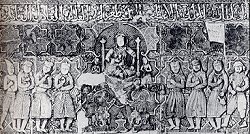Central Asian paintings and sculpture
Printed From: History Community ~ All Empires
Category: General History
Forum Name: Historical Arts and Architecture
Forum Discription: Discuss arts, literature, and architecture before the 19th century
URL: http://www.allempires.com/forum/forum_posts.asp?TID=1827
Printed Date: 19-Apr-2024 at 22:28
Software Version: Web Wiz Forums 9.56a - http://www.webwizforums.com
Topic: Central Asian paintings and sculpture
Posted By: Cyrus Shahmiri
Subject: Central Asian paintings and sculpture
Date Posted: 13-Jan-2005 at 15:08
|
Source: http://www.unesco.org/culture/asia/html_eng/chapitre4216/chapitre8.htm - http://www.unesco.org/culture/asia/html_eng/chapitre4216/cha pitre8.htm Wall paintings showing thematic compositions, and also sculpture, were commonly included in the interior decor of both secular and religious buildings in Central Asia during the pre-Islamic period. However, the arrival of Islam brought about changes in the nature of religious buildings and palaces which, together with religious prohibitions, led to changes in the forms and stylistic features of both sculpture and wall painting. This process, which developed variously in different regions of the Islamic world, continued for many decades. The wall paintings and sculptures discovered in the palaces of the eighth to the ninth century near Samarkand (Panjikent, Afrasiab), Bukhara (Varakhsha) and Nishapur represent the splendid swansong of the representational arts of early medieval Sogdia and Iran. In the Sasanian period, when glorification of the legendary and epic past was encouraged, the interiors of palaces were still being decorated with paintings and sculptured reliefs illustrating hunting scenes, royal receptions (Fig. 10) and epic themes recalling the lives of ancient kings, as witness the paintings from Afrasiab and Varakhsha. The motifs of Sasanian art are encountered in mural compositions and stucco carvings of the eighth and ninth centuries discovered in the remains of Islamic palace buildings of Nishapur. A traditional hunting scene is depicted on a fragment of wall painting but the appearance of different figures and attributes must be viewed as a concession to the new era. Instead of the lion hunts favoured by the Sasanians, the picture shows a horseman with a hawk on his forearm: his prey is a hare. The grand, monumental quality of Sasanian art gives place to the stylized decorative compositions of the new age.
------------- 
|
